
* In the final years of the Cold War, in the belief that the USSR was developing improved fighter aircraft, a number of Western nations began their own efforts to develop advanced "fourth-generation" fighters to counter the Soviet threat. The French entry into this field was the Dassault "Rafale". Although the collapse of the Soviet Union meant that the threat the Western fourth-generation fighters were built to face didn't materialize, air forces still need improved fighters to replace aging existing aircraft, and the Rafale is now France's first-line combat aircraft. This document provides a history and description of the Rafale.
* Different Western nations had slightly different specific motives for developing a fourth-generation fighter. In the late 1970s, the French Armee de l'Air (AA, the Air Force) was already fielding the new Dassault Mirage 2000 multi-role fighter, and was considering a next-generation successor. The AA also was faced with the obsolescence over the next two decades of many of their current first-line aircraft, including the Dassault Mirage III, 5 and F1 fighters; the Dassault Mirage IV bomber; and particularly the SEPECAT Jaguar strike aircraft. The AA requirement for a replacement emerged as the "Avion de Combat Tactique (ACT / Tactical Combat Aircraft)".
Similarly, the Aeronavale (the French naval air arm) needed a replacement for the Dassault Etendard and Super Etendard strike aircraft, and in particular the service's US-built Vought F-8 Crusader fighters. The Aeronavale requirement emerged as the "Avion de Combat Marine (ACM / Naval Combat Aircraft)".
There were many areas of convergence between the AA and Aeronavale requirements, and so the two services were able to agree to develop a single multi-role fighter to meet their needs. This agreement emerged in the form of a requirement for a demonstrator, designated the "Avion de Combat Experimental (ACX / Experimental Combat Aircraft)", as a first step towards an operational aircraft. The ACX requirement specified an aircraft with a weight of about 9 tonnes (10 tons) that could carry at least six air-to-air missiles (AAM) in the air combat role, and up to 3,500 kilograms (7,715 pounds) of ordnance over a combat radius of 650 kilometers (405 miles) in the attack role. This would turn out to be a relatively modest specification compared to the aircraft that finally emerged.
Dassault was authorized to begin full development of an ACX demonstrator in early 1983, naming the machine the "Rafale (Squall)", while SNECMA began work on a new afterburning bypass jet engine for the ACX, the "M88". Two Rafale demonstrators were actually specified at the outset, but the order was later cut to one. Dassault used their "Computer Aided Three-dimensional Interactive Application (CATIA)" digital design system for the Rafale, bringing the company out of the printed-blueprint age, and into the digital age.
There were discussions with other potential European partners before and after this decision, but the French were insistent on developing a machine tailored to their own requirements, with France firmly in the driver's seat. The French were not inclined to compromise; their position was a "nonstarter", with the British, Germans, Italians, and Spanish moving off in 1985 to develop their own fourth-generation fighter, the "EuroFighter", in parallel with the Rafale. The French went it almost completely alone in building the Rafale -- not even leveraging major subsystems off of foreign technology, as the Swedes did with their Gripen fourth-generation fighter.
* Dassault began work on a "Rafale A" technology demonstrator effort in March 1984, with the machine rolled out on 14 December 1985. It was a sleek, single-seat, canard delta machine, fitted with two General Electric F404-GE-400 afterburning bypass jets as used by the US F-18 Hornet, since the SNECMA M88 was not ready at that time. The demonstrator performed its first flight on 4 July 1986. It exceeded Mach 1.3 on this initial flight and Mach 1.8 a few days later. The Rafale A made its first formal public debut in September 1986. The demonstrator's capabilities were impressive enough to encourage the French Ministry of Defense to place a production order for the Rafale in April 1988.
The Rafale A continued to perform test flights in support of the development program. Although not capable of carrier operations, its flight test program included approaches and "touch and go" landings on the carriers CLEMENCEAU and FOCH to see if the design had any inherent "show stoppers" for carrier operations. As it turned out, the Rafale A's approach speed was even lower than that of the Super Etendard or the Crusader.
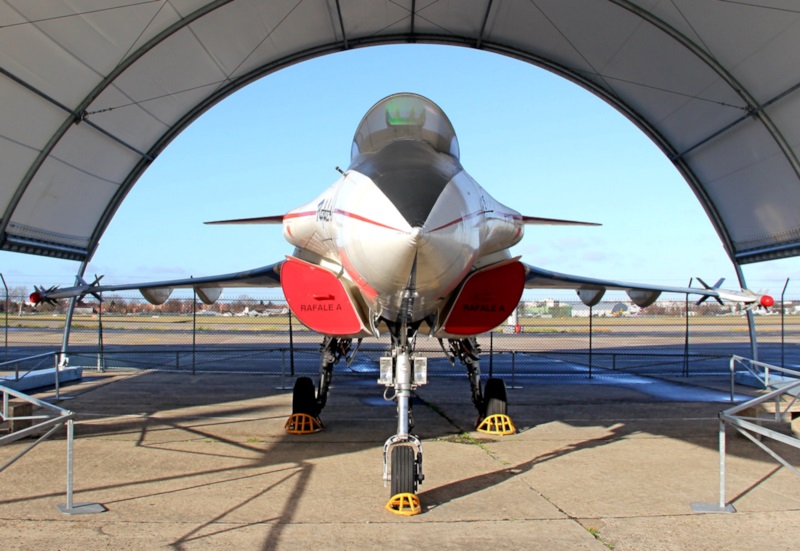
In May 1990, the Rafale A was refitted with one SNECMA M88 bypass jet engine, intended for production Rafales, replacing the left-side GE F404. The Rafale A was finally retired in 1994, with prototypes for operational Rafales taking its place in the flight test program. The Rafale A ended up on display at EPNER, the French test pilot school in Istres, but was later moved to the Dassault plant at Saint-Cloud. It remained on display there, until the local authorities claimed that it was causing an unusual number of traffic accidents on the road outside the plant; Dassault was asked to move it.
* The production order envisioned three versions of the Rafale:
Due to the defense shufflings that followed the end of the Cold War, the Rafale program encountered repeated delays, but still managed to go forward. The black-painted "C01" prototype of the Rafale C performed its first flight in May 1991. Although two Rafale C prototypes had been planned, the second was judged redundant, but two prototypes, numbers "M01" and "M02", were built for the Rafale M. M01 took to the air in December 1991 and M02 followed in November 1993. The prototype for the Rafale B two-seater, "B01", performed its initial flight in April 1993, before the flight of M02.
M01 took a trip to the US in the summer of 1992 to perform initial carrier catapult trials, using a land-based facility at US Naval Air Station Lakehurst in New Jersey, Europe having no comparable facility. M01 performed its first true carrier landing, on the FOCH, in April 1993.
BACK_TO_TOP* The Rafale C defined a baseline configuration for the Rafale family. The remarks below apply to the Rafale C, and are followed by descriptions of the other variants and their differences from the Rafale C.
As introduced, the production Rafale had essentially the same general configuration as the Rafale A, but was slightly smaller. It also featured changes to reduce its "radar cross-section (RCS)", such as improved airframe contours, use of "radar absorbing material (RAM)", and a gold-plated canopy. In fact, for a time in the early 1990s, Dassault advertised the type as the "Rafale D", where "D" stood for "Discreet", to emphasize its semi-stealthy nature.
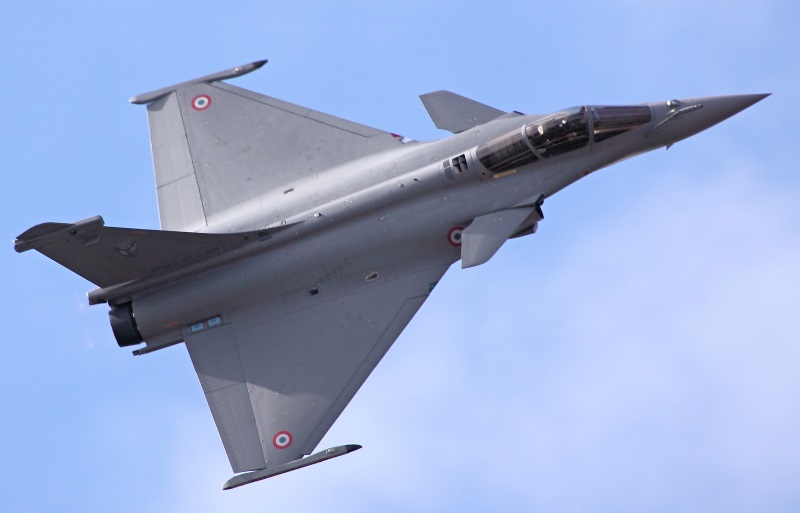
The Rafale C also featured much more use of composite materials than the Rafale A, which reduced both the aircraft's RCS and weight. It was relatively small for a twin-engine fighter, with an empty weight about 1,360 kilograms (3,000 pounds) greater than that of a single-engine F-16C, and a maximum take-off weight about 4,535 kilograms (10,000 pounds) greater.
The Rafale was powered by two SNECMA M88-2 bypass jet engines, with 50 kN (5,100 kgp / 11,240 lbf) dry thrust and 75 kN (7,645 kgp / 16,860 lbf) afterburning thrust each, and fitted with "full authority digital engine controls (FADEC)". The engine inlets were fixed. The engines were started by a Microturbo auxiliary power unit (APU) turbine, which also provided ground power for aircraft systems. The M88-2 was designed to be powerful, reliable, and easy to maintain, with a modular configuration that made it relatively simple to swap out subassemblies. The M88-2 had prompt throttle response over a wide range of thrust, and required no "babying" by the pilot.
SNECMA worked on an uprated M88-3, but there was no great interest in it, and it was canceled. SNECMA went on to introduce a modest update to the update to the M88-2 to the "M88-4E" standard, which was refitted from 2012, and improved reliability and serviceability.
The Rafale featured a compound-sweep low-mounted main wing, and all-moving high-mounted canard foreplanes mounted just behind the cockpit. The wing had full-span elevons and leading edge slats. On the prototypes, there was an airbrake on either side of the fuselage, just forward of the tail, but the airbrakes were deleted in production machines.
The Rafale was aerodynamically unstable to provide agility; the machine featured a digital "fly-by-wire (FBW)" system to keep it flying right. The fighter also had excellent short-field capabilities. A brake parachute was fitted in a fairing below the tailfin.
The aircraft had a fixed, removable inflight refueling probe mounted on the upper right side of the nose, and tricycle landing gear. The nose gear had twin wheels, while the main gear had single wheels, all retracting forward. The Rafale was designed to be reliable and easy to maintain under austere field conditions.
___________________________________________________________________
DASSAULT RAFALE:
___________________________________________________________________
wingspan:
10.90 meters (35 feet 9 inches)
wing area:
46.0 sq_meters (495.16 sq_feet)
length:
15.30 meters (50 feet 2 inches)
height:
5.34 meters (17 feet 6 inches)
empty weight:
9,060 kilograms (19,975 pounds)
MTO weight:
19,500 kilograms (42,990 pounds)
max speed:
2,130 KPH (1,325 MPH / 1,150 KT)
combat radius:
1,095 KM (680 MI / 590 NMI)
___________________________________________________________________
* The Rafale was fitted with a single 30-millimeter GIAT 791B cannon, mounted on the right engine duct. The GIAT 791B had a cyclic rate of fire of 2,500 rounds per minute; the fighter carries an ammunition store of 125 rounds.
The Rafale C featured 14 external stores attachments, including wingtip rails for "dogfighting" AAMs, as well as for airshow smoke generators; three stores pylons under each wing; fore and aft conformal stations for AAMs on each side of the fuselage; and fore and aft centerline pylons -- the Rafale M lacked the forward centerline pylon because of the larger nosewheel, so it had 13 stores attachments. Total external warload capacity was 9,500 kilograms (20,925 pounds). Possible AAM loads included the proven Matra / BAE Dynamics Magic heat-seeking AAM and its follow-on, the Matra / BAE Dynamics "Missile d'Interception, de Combat d'Autodefense (MICA / Missile for Interception, Combat, & Self-Defense)".
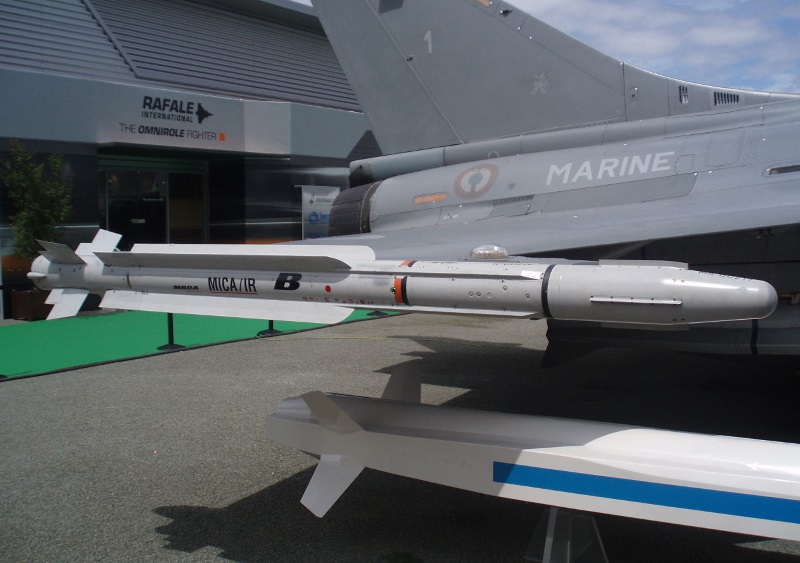
The MICA was designed in parallel with the Rafale development effort. It was a highly agile, relatively long-range missile and came in two versions:
The MICA IR had a "launch before lock" capability, allowing it to engage distant targets without giving much warning of its approach through a radar signal. The MICA EM was capable of "fire and forget" operation. In the air defense role, the Rafale could carry up to ten MICAs. The Rafale was later qualified to carry the long-range, ramjet-powered Matra / BAE Dynamics "Meteor Beyond Visual Range AAM (Meteor BVRAAM)". A Rafale could carry up to eight Meteors.
While the aircraft could carry dumb bombs and unguided rocket pods, the push these days is towards smart munitions. The Rafale could carry US Paveway laser-guided bombs (LGBs), guiding them with the Thales Damocles targeting pod, and could also carry the Matra-BAE Dynamics "Apache / Scalp" cruise missile. The Apache and Scalp were almost identical externally, with a boxy fuselage, pop-out "switchblade" wings, and a belly air intake -- but the Apache carried a submunition warload, while the Scalp carried a unitary hard-target penetrating warhead. The Apache was not actually carried by French Rafales, but it was an option for export Rafales.
The French developed their own guided-bomb system, under the designation "Armament Air-Sol Modulaire (AASM / Modular Air To Surface Armament)", known as "Highly Agile Modular Munition Extended Range (HAMMER)" for export. ASSM provided modular components to fit dumb bombs with a Global Positioning System / Inertial Navigation System (GPS/INS) guidance kit, or an INS guidance kit with a "smart" imaging infrared seeker -- either guidance system using a nose fin assembly to steer the bomb -- as well as a tailfin assembly, with a rocket booster and popout fins, to increase span and range. Combat proved AASM highly effective.
Another Rafale store was the "Air Sol Moyenne Portee A (ASMPA / Air to Surface Medium Range A)" ramjet-powered, Mach 2.5, nuclear standoff missile. ASMPA was a follow-on to the earlier ASMP standoff missile carried by the Mirage 2000, with double the range. An antiship variant of the ASMPA, the "ANF", has been considered, but the Rafale was qualified for the proven Exocet antiship missile in any case.
French Rafales were able to carry the Thales "Reconnaissance Nouvelle Generation (Reco NG)" digital reconnaissance pod, which contained day-night electro-optical sensors in a rotating turret, resident processing power, a solid-state recorder, and a high-speed datalink.
The Rafale's rear centerline pylon and the two inner wing pylons on each wing were "wet" and could be used for carriage of external tanks. All five wet pylons could carry 1,150-liter (304 US gallon) fuel tanks or 1,250-liter (330 US gallon) supersonic fuel tanks. Up to three of the big bulbous-nosed 2,000-liter (528 US gallon) external tanks, much like those developed for the Mirage 2000 but lacking tailfins, could also be carried, with one on the centerline pylon and one on the inner wet pylon on each wing. A centerline buddy refueling pack could be carried -- though only by Aeronavale Rafales in French service, the AA having other tanker assets. Carriage of the tanker pod involved fit up to four external tanks -- two 1,250-liter and two 2,000-liter tanks.
* The pilot sat on a Martin-Baker Mark 16F "zero-zero" (zero speed, zero altitude) ejection seat -- one of the few major concessions to foreign technology in the Rafale -- inclined 29 degrees to improve pilot tolerance to gee forces, under a canopy that hinged open to the right. An "on-board oxygen generating system (OBOGS)" eliminated the need to stockpile oxygen canisters.
The pilot flew the aircraft with a sidestick controller mounted on the right side of the seat and a throttle on the left, both studded with "hands on throttle and stick" controls. The Rafale also provided "direct voice input (DVI)" capabilities, allowing the pilot to perform actions through spoken commands. The DVI system had a vocabulary of 90 to 300 words, with first-time recognition 95% of the time. DVI was not included in initial production Rafales.

The Rafale featured a "glass cockpit", and a comprehensive combat avionics suite. The glass cockpit was startlingly austere, and would probably have been a complete shock to a fighter pilot from the days of dials and indicators. It included a wide-angle holographic "head up display (HUD)" to display most of the relevant information using sophisticated symbology, and two accessory color flat-panel multifunction displays (MFDs) with touch input overlays. Pilots wore special silk-lined leather gloves with no seams on the fingertips to use the touch overlays; the gloves also had chamois pads for cleaning the screens. In addition, the pilot had a Sagem Gerfaut helmet-mounted sight, though this was also not included in initial production.
The avionics suite included:
* The Rafale B was very similar to the Rafale C, except of course for the tandem seats. The two seats were covered by a one-piece canopy that hinged open to the right. The Rafale B was fully equipped with operational kit, with the control layout for the front and back seats made as similar as possible to ensure maximum operational flexibility. It had an empty weight about 350 kilograms (772 pounds) greater than the Rafale C, and less internal fuel capacity.

The Rafale B was originally seen primarily as a conversion trainer, to be purchased in small quantities. It was believed that improvements in aircraft avionics would allow the pilot of the single-seat Rafale C to perform all operational missions. However, the Gulf War in 1991 suggested to the AA that strike and reconnaissance missions often required two aircrew, and so the service then increased the proportion of two-seaters in their buy to 60%.
* The Rafale M was very similar to the Rafale C, the only really visible differences being taller, longer nose gear with catapult attachment fixtures, and fit of a stinger-type arresting hook under the tail. As mentioned earlier, the longer nose gear -- which gave the Rafale M a nose-up attitude on the ground -- required removal of the front centerline stores pylon.
The Rafale C and B actually did have a runway arresting hook, but it was much less prominent. The Rafale M required a much more formidable hook since a carrier jet snags the cable at full throttle in case the landing is a "bolter", and the aircraft has to come around for another try.
Other changes to the Rafale M included a stronger airframe and main gear to withstand "smackdown" landings on carriers; a built-in, power-operated pilot boarding ladder; a carrier microwave landing system that made landings much easier than with earlier French carrier aircraft; and a "Telemir" inertial navigation system that could obtain position reference data from the carrier. The modifications to the Rafale M added about 500 kilograms (1,100 pounds) to its empty weight relative to the Rafale C. In the interests of commonality with other Rafale variants, the Rafale M did not have folding wings. Early on, no two-seat version of the Rafale M was envisioned, but later the Aeronavale decided to acquire a two-seat "Rafale BM" -- and still later decided not to after all.
BACK_TO_TOP* Although the Rafale development program went well, the program did not go quite so smoothly politically. The somewhat unexpected end of the Cold War caused complications for all the Western fourth-generation fighter efforts, resulting in program stretchouts and reduced buys. The projected buys were, after cuts, 212 Rafales for the AA and 60 Rafales for the Aeronavale.
First flight of a production Rafale, an Aeronavale Rafale M, was in July 1999, the same day the M02 prototype Rafale M landed on the new French aircraft carrier CHARLES DE GAULLE. The Aeronavale's requirements were regarded as more pressing than those of the AA, since the Aeronavale's "first line" air combat fighter was the honored but antiquated Vought Crusader, while the AA had the perfectly modern Mirage 2000.
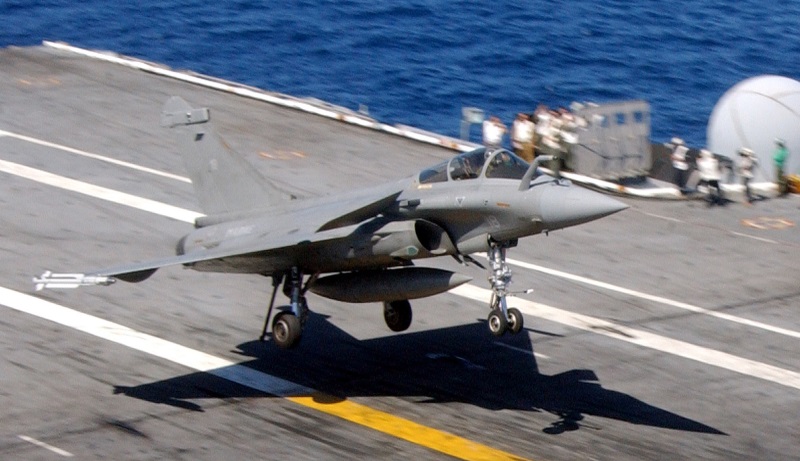
Initial service deliveries of the Rafale M were in December 2001, with the first Aeronavale Rafale M squadron fully operational, on the CHARLES DE GAULLE, in the summer of 2002. As with the EuroFighter, the Rafale went into service in a phased fashion.
The first Rafales to be delivered were configured to "F1" standard, which only included capabilities for air-to-air combat and a baseline avionics suite, that being the minimum needed to replace the Aeronavale's elderly F-8 Crusaders. The F1s were armed with cannon, plus the Magic and MICA EM missiles. The first few production Rafale Ms, which were put into service in a relative hurry, were delivered in a "sub-F1" standard designated "LF1", which featured an older mission computer instead of the MDPU and lacked the built-in cannon. The LF1 machines were later updated to F1 standard.
The "F2" standard added strike capabilities, including carriage of LGBs and the Apache / Scalp cruise missile, as well as fit of the cannon; provision of air-to-surface and terrain-following modes to the RBE2 radar; and brought the FSO sensors and Link 16 datalink on board. Along with the surface attack weapons, the F2 specification permitted carriage of the MICA IR, replacing the Magic, and added support for carriage of the buddy tanker pack.
The full "F3" standard, with initial deliveries in 2009, brought the Rafale up to complete multi-role operational capability, with implementation of all currently planned modes for the RBE2 radar, adding AASM capability, as well as missions such as nuclear strike, with the ASMPA; antiship attack with the Exocet or ANF; and reconnaissance with the Reco NG pod. The F3 standard also added DVI and other cockpit enhancements; the Gerfaut helmet-mounted sight; support for the "Rover" ground-air datalink system; and support for an improved tanker pod, the "Nacelle de Ravitaillement en Vol de Nouvelle Generation (NARANG / New Generation In-Flight Refueling Pod)".
All F1 and F2 standard Rafales were brought up to F3 standard in the course of scheduled high-level maintenance -- the Rafale was designed to be relatively easy to update, so it has not greatly suffered from "revisionitis".
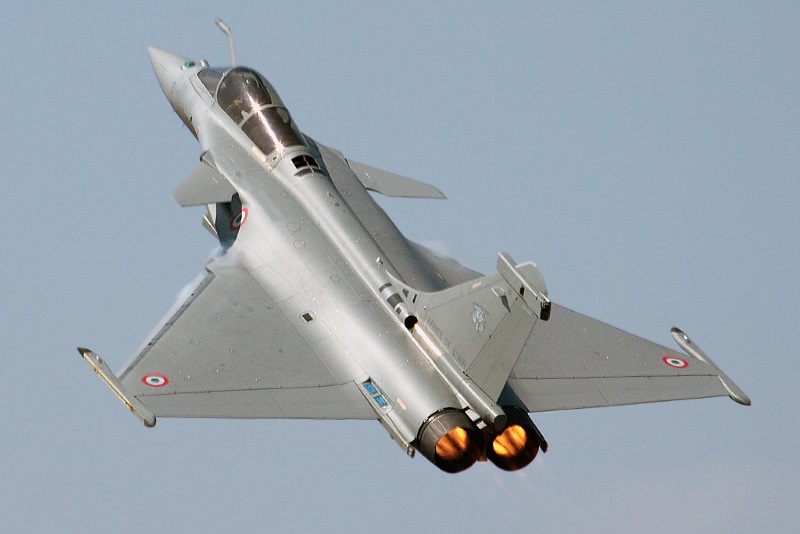
An "F3R" -- AKA "F3+" or "F3-04T" -- standard was then developed to improve multi-role integration and strengthen the Rafale's position in the export market. One of the big improvements of the F3R standard was an "Active Electronically Scanned Array (AESA)" derivative of the RBE2 radar, designated the "RBE2-AA". An AESA can be thought of as an "RF array processor", made up of a grid of "transmit/receive (T/R)" modules, more than a thousand of them, that each have transmitter and receiver circuitry. The T/R modules operate together, with some modules being programmed to perform one set of functions, say to operate as a radar, while others simultaneously operate as, say, a jammer.
The RBE2-AA had substantially increased range, up to double for some modes, with a wider field of view, and improved resolution. It was easily swapped out, with AESAs switched between Rafales as operational requirements demand. Thales was awarded a contract in 2004 to develop the AESA system. It was relatively straightforward to implement, the only significant changes in the RBE2 being the array itself and new software for the radar. A demonstrator was flying by the fall of that year, and the first production machine with the RBE2-AA delivered in late 2012.
F3R also included:
The first F3R machines were delivered to the AA for evaluation in late 2013, with introduction to service in 2019; they are now production standard. New weapons have been introduced. Operations of AA combat assets in Afghanistan encouraged development of smaller guided munitions, such as unguided rockets fitted with laser guidance heads or 20-kilogram (44-pound) class guided glide bombs. Larger munitions were costly and overkill for fighting insurgents, particularly in urban areas where heavier munitions could result in severe "collateral damage".
In 2020, the AA became the Armee de l'Air et de l'Espace (AAE / Air & Space Force). At that time, work was being done on a "Rafale F4" standard -- the effort having been announced in 2017, with first flight of a prototype in 2021 and introduction to service expected in 2025. Some F3Rs were updated to F4 standard from 2023 for evaluation. The F4 standard included:
There's thought of working towards a "mid-life upgrade" in the post-2025 timeframe that would be stealthier and have extensive conformal antennas, and a next-generation "Rafale NG" in the 2035 timeframe, with substantial airframe modifications for stealth or increased fuel.
Initial delivery to the AA, of a two-seat Rafale B, was in December 2000. Introduction to operational AA squadron service, with aircraft to F2 standard, was in the summer of 2006. Some of the aircraft were placed on "quick reaction alert" to help defend against terrorist actions, and by the spring of 2007 six were in combat operations in Afghanistan, supporting NATO troops fighting Taliban insurgents. They were F2 standard machines, hastily upgraded to provide LGB and improved self-defense capability. They were not initially capable of carrying the Damocles pod, and had to rely on other ground forces or Mirage 2000Ds for targeting.
The Rafale introduced the AASM to combat in Afghanistan in 2008. A deployment there in 2010 featured F3-standard machines that could carry the Damocles and the Reco NG pod, with full qualification of weaponry. Rafales participated in the NATO air campaign in support of the Libyan revolution in 2011, the Rafales being kitted up with Damocles and AASM. They later supported the 2013 French intervention in Mali against Islamists -- this campaign gradually expanding into attacks on Islamists in the Central African Republic and Nigeria -- and then the multi-national campaign against Islamic State (IS) insurgents in Iraq and Syria from 2014.
A particularly intensive series of strikes were performed against IS, following the bloody terror attacks in Paris on the night of 13:14 November 2015. One of the Rafales operating against IS was spotted with a "kill mark" for a drone in 2019; details were not known, but that would seem to indicate the Rafale's first air-to-air kill. Since that time, Rafales have participated in NATO Baltic air patrols to shield against Russian adventurism.
All of the 272 originally planned French Rafales should be delivered by 2024 -- along with some number of replacement aircraft, likely stretching beyond that time. The AA decided not to have a fleet consisting of 60% Rafale Bs after all, with the two-seaters to be obtained only for conversion training and the nuclear strike mission, reducing the proportion of two-seaters to about 40%. The improved software provided by the F3 standard allowed the single-seaters to perform complex missions without overburdening the pilot.
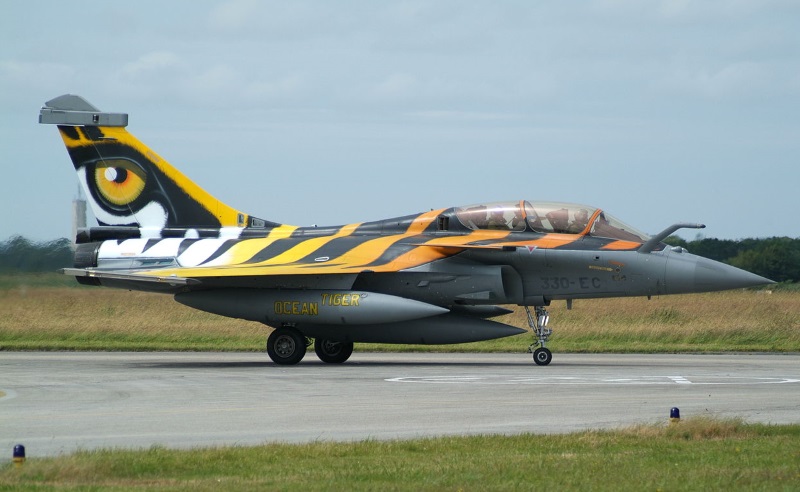
* Dassault officials are considering next-generation improvements to the Rafale, with features such as thrust-vectoring and uprated M88 engines; improved stealth; and enlarged AESA arrays to provide greater spherical coverage. A high-profile future option is next-generation computing systems and data links to allow a two-seat Rafale B to control drones as decoys, or for reconnaissance and strike support. Reconnaissance drones would be able to identify targets and even designate them with a laser for attacks with guided munitions launched by the Rafale, or an armed drone could perform the attacks directly. Communications between the Rafale and the drones could be performed over satellite links, and such communications links could also be used by the Rafale to obtain information from surveillance platforms, such as an AWACS or battlefield surveillance / control aircraft.
Dassault has also worked along with the French space agency CNES on a very interesting scheme for the Rafale, the "Airborne Micro-Launcher (AML)", which would be a spacelift booster carried by the Rafale to put small satellites into low Earth orbit (LEO). The initial concept envisioned a launcher carried on the aircraft's centerline pylon that could put a 50-kilogram (110-pound) satellite into LEO, but later thinking led to a launcher carried on the centerline pylon augmented by twin solid-rocket boosters, connected by standoffs and fitted to the Rafale's main wing pylons. This configuration could put a very capable 150-kilogram (330-pound) satellite into LEO.
The main potential client was the French military, which wanted a "quick response" space launch capability. There is also interest in the potential use of the AML as an anti-satellite (ASAT) weapon, but that is controversial. The Americans and Soviets worked on ASATs as far back as the 1960s, but never did more than perform test shots with them: once one side started nailing the other's satellites, retaliation would be certain to follow. The intercepts would not merely wipe out the military space assets of both sides, but also strew near-Earth space with debris that would render low-orbit operations very difficult. However, so far the AML doesn't appear to have gone any farther than the concept stage.
* Dassault has banded together with Thales and SNECMA in the "Rafale International" business group, which is working on a Mark 2 export version of the fighter. Dassault has a 60% share in the group, while Thales and SNECMA both have a 20% share. The Rafale Mk.2 will have the uprated SNECMA M88-3 powerplant with 20% more thrust; improved ground attack software; the AESA RBE2 radar; and conformal fuel tanks.
The Rafale was slow to win export orders. In 2002, Dassault lost the award for a South Korean competition to the Boeing F-15, which frustrated Dassault officials to the point where they considered for a time a legal challenge to the award. Dassault was similarly scooped by the F-15 in a deal for Singapore; the company seemingly scored a win in the summer of 2009 with Brazil indicating interest in ordering 36 Rafales -- but then the Brazilian requirement went on hold, and was eventually picked up by the SAAB Gripen.
The first official win was with India, with the Indian government indicating that the Rafale won a requirement for 126 aircraft. However, weapons deals with India have a reputation for being troublesome -- a reputation that was confirmed when the contract was officially canceled, the stated reason being a failure to come to agreement on local assembly. That ended up being just a stage in the negotiations, with the two parties then coming to an agreement for 36 Rafales, with deliveries in 2020:2022.
The firm also won an order for 24 Rafales from Egypt in early 2015, including 16 "Rafale BG" two-seaters and 8 "Rafale E" single-seaters, with the first three Rafales to be delivered in that year, and the last delivered in late 2018. 30 more were ordered in 2021, with deliveries in 2024:2026. There have been other orders:
* Sources include:
* Illustrations details:
* Revision history:
v1.0.0 / 01 dec 02 v1.0.1 / 01 nov 04 / Review & polish. v1.0.2 / 01 nov 06 / Review & polish. v1.0.3 / 01 apr 07 / Rafale in Afghanistan. v1.0.4 / 01 mar 09 / Review & polish. v1.0.5 / 01 jun 09 / Review & polish. v1.0.6 / 01 may 10 / Review & polish. v1.0.7 / 01 apr 12 / India sales win. v1.0.8 / 01 mar 14 / F3R deliveries. v1.1.0 / 01 feb 16 / General update. v1.1.1 / 01 jan 18 / Review, update, and polish. v1.1.2 / 01 oct 19 / Review, update, and polish. v1.2.0 / 01 sep 21 / Review, update, and polish. v1.3.0 / 01 sep 23 / Review, update, and polish. (*)BACK_TO_TOP
